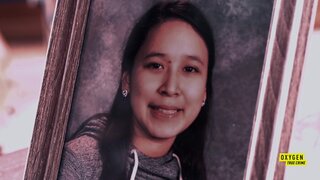Create a free profile to get unlimited access to exclusive videos, breaking news, sweepstakes, and more!
How Murals, Opera And Theater Raises Awareness of Murdered And Missing Indigenous Women
Art can be a sign of solidarity as well as a vehicle to raise awareness of a critical issue and inspire action, as evidenced by these plays, exhibits, and other forms of artistic expression about the continuous cases of murdered and missing Indigenous women.
Oxygen’s upcoming special, “Murdered and Missing in Montana," takes a deep dive into unsolved cases of Indigenous girls who vanished and were later found dead. For former Los Angeles prosecutor Loni Coombs, who leads the two-hour special, airing Friday, November 12 at 8/7c questions loom about how the crimes were investigated and the attention they received. They stand in stark contrast to the spotlight on the Gabby Petito case, for example.
The cause of murdered and missing Indigenous women (MMIW) extends well beyond Montana. To raise awareness of MMIW issues, individuals and organizations are using art and forms of artistic expression as wake-up notices to the trauma and suffering — and as calls to action. Here’s a small sampling.
Painted handprints a vivid symbol of support
One of the most recognizable symbols of solidarity with MMIW is the red handprint, painted across the mouth. If a picture is worth a thousand words, the same is true for this bold representation of women silenced by violence.
The symbol turned heads when Jordan Marie Brings Three White Horses Daniel, a competitive runner, ran the 2019 Boston Marathon with a red handprint painted across her mouth. The Kul Wicasa Lakota athlete also wore the letters MMIW on her body.
“Every mile, Daniel said a prayer for a different Indigenous woman or girl affected by the MMIW epidemic — 26 in all,” reported Runner’s World in 2020. Daniel referred to MMIW as “an epidemic happening to every Indigenous community, whether that's on the reservation, urban, or rural.”
Lost lives remembered in larger-than-life murals
Around the U.S. and Canada, walls of buildings have become large-scale canvases to recall MMIW whose lives have been lost. In Smithers, Canada, one such “display of love and grief” was recently completed on Main Street to commemorate women and girls who have gone missing along the infamous Highway of Tears.
Murdered women and girls are given a voice
When it comes to expressing the human condition, and that includes its darkest and most tragic dimension, “art is a powerful tool,” says Reed Smith, general director of Anchorage Opera in Alaska. “Missing,” a chamber opera by Marie Clements and Brian Current is set to make its U.S. premiere in February 2022 at the Alaskan company.
The opera follows a woman’s connection to a murdered Indigenous girl and becomes “a dreamscape” in some parts, Smith told Oxygen.com. In addition to illuminating a serious problem, Smith is hopeful that the work brings “some sort of healing for members of the Indigenous population.”
MMIW stories are summoned for the stage
Hard-hitting cultural and social issues have always been grist for theater, and plays dramatizing stories of murdered and missing Indigenous women have been staged around the U.S. and beyond, including such works as “Big Green Sky,” a play commissioned by a local theater group in Canada.
For “Menil and Her Heart,” teenaged author Isabella Madrigal, a tribal member of the Cahuilla Band of Indians in California, drew inspiration from ancient Cahuilla tales. The play follows two sisters, one of whom goes missing.
In a 2019 Palm Desert Sun interview, Madrigal said that the MMIW issue hits close to home. “A lot of our cast members know about this, have dealt with this. Bringing it to a larger audience is part of the healing process. It’s also part of the awareness raising process.”
Consciousness raised one exhibit at a time
One of the aims of “Sing Our Rivers Red,” an installation that concluded its run at the Dairy Arts Center in Boulder, Colorado in mid-October, was to “raise awareness, unite ideas, and demand action for Indigenous women, girls, and two-spirit relatives who have been taken, tortured, raped, trafficked, assaulted and murdered.”
The exhibition presented more than 5,000 earrings, separated from a pair. “Each earring represents a current Missing and Murdered Indigenous Women and Girls (MMIWG) case in North America,” according to the center’s promotional materials. The visual spoke volumes about the issue. It added “to the evocative narrative of the trauma and suffering,” one reviewer wrote.
Like a single earring, other items have become creative expressions that highlight the violence against Indigenous women. Clothing and clay beads are used respectively by the REDress Project and the MMIWQT Bead Project.
For a more in-depth look at this issue, watch “Murdered and Missing in Montana,” airing Friday, November 12 at 8/7c on Oxygen.






















